Energy can be divided up into two separate categories, Conventional
(unsustainable) and Sustainable (renewable).
Written by: Peter Nichol (Web Page Creator)
Conventional sources include fossil fuels such as oil, coal and natural
gas as well as natural gas plant liquids. These fossil fuels are organic
chemicals created from dead and decayed organisms which thrived millions
of years ago.
Coal:

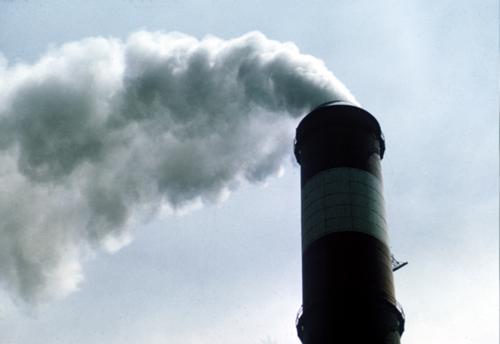 A front loader piles coal at Niagara Mohawk's Dunkirk
steam station in New York
A front loader piles coal at Niagara Mohawk's Dunkirk
steam station in New York
Typically coal is found within ancient swamps, on land where layers
of organic materials have been buried over time, subjected to heat, pressure
and time. World coal deposits are said to be as much as 10 times more vast
than both oil and gas resources combined. Coal seems can be as vast as ancient
swampy forests, sometimes 100 meters thick and potentially extending tens
of thousands of square kilometers. This total recourse is estimated to be
as much as 10 trillion metric tons. Most of the estimated coal within the
earths crust is lies far beyond mans ability to extract, therefore only a
small percentage of the estimated deposits are within the ability to extracted
and consumed. Besides the fact that coal is non-renewable, it is also a
major ail polluter. Every year 900 million tons of coal is burned within
the U. S. alone. This burning of coal is responsible for releasing 18 million
metric tons of sodium dioxide, 5 million metric tons of nitrogen oxides,
4 million metric tons of airborne particles, 600,000 metric tons of hydrocarbons
and carbon monoxide and almost a trillion metric tons of carbon dioxide.
All of these combined, mainly the sulfur and nitrogen oxides combined with
water droplets in the atmosphere create sulfuric and nitric acid; these create
acid rain. Acid rain leaches soils at a much greater rate than natural leaching
leaving soils more acidic, it also reduces plant growth, and adds to the
degradation of chlorophyl in plants which increases the plants venerability
to insects, and disease. Coal is also very inefficient as an energy source.
Of all the energy harnessed using coal, the same amount is lost through heat
via the second law of thermodynamics (Once energy is transferred, there is
less of that energy available). Coal ranked 52% in electricity generation
in the U.S. during the year 2000.
Petroleum:
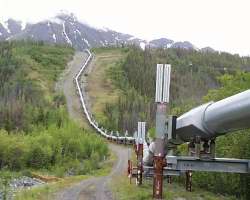
The trans-Alaska
oil Pipeline
Typically found within ancient marine basins where phytoplankton,
low levels of oxygen and organic rich compounds have been subject to burial,
heat, pressure and time. It has been said that the total amount of oil in
the world is estimated to be about 4 trillion bbl (600 billion metric tons),
half of which is thought to be recoverable. Of this amount, roughly 465
bbl of oil already have been consumed. It is estimated that another 800
billion bbl either remain to be discovered or are not recoverable when considering
the cost and current technology. The Gulf of Mexico has recently been tagged
at a major possible source of crude oil in massive amounts. But these finds
are much further out at sea and in much deeper water than already existing
oil platforms. Therefore it may only be a mater of time in the development
of new recovery technology before these vast reserves are tapped. Like coal,
petroleum more often than not also contains high sulfur levels. Oil combustion
through heating and transportation is responsible for sometimes half of the
volatile organic compounds, nitrogen oxides, and carbon monoxide emitted
into the atmosphere each year. Currently, transportation makes up for 98%
of the oil consumption within the U.S.
Natural Gas:
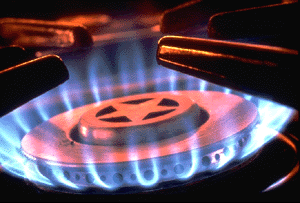
A typical house hold gas range.
Natural gas is the
world's third largest commercially available fuel; it represents about 23%
of the global energy consumption. It is cleaner to burn than both oil or
coal because natural gas produces only about half as much carbon monoxide
in our atmosphere, therefore it is the cleanest fossil fuel. It is also
efficient and easy to extract from it's natural reserves. Unfortunately,
natural gas is difficult to ship across large masses of water or store in
large quantities. Developed countries have the advantage of pipeline networks
to carry a supply of gas to specific markets, where undeveloped countries
tend not to have these pipelines making it far to expensive and almost impossible
to use the gas as energy. Developing countries where oil is exported must
simply burn (flared off) the natural gas produced in conjunction with oil
pumping because of the lack of a natural gas infrastructure.
Sustainable
sources of energy can include Nuclear power, Hydroelectric, Geothermal,
Solar, Tidal, Wind power, and most biomass. These each produce energy in
very different ways and are different from fossil fuels because they are
renewable rather than exhaustible.
Nuclear Power:

Mochovce nuclear plant
In 1953 the U.S.
Energy Department was all in support of nuclear power and the idea of an
over abundance of energy for the future at a price "too cheap to meter".
The idea of nuclear fission, the splitting of large atoms, would create this
clean, safe, cheap and abundant supply. Fortunately, this process of manufacturing
energy became quite unpopular as a result of both the Three Mile Island (1979)
and Chernobyl (1986) nuclear disasters. Nuclear fission is created by using
neutrons that split the uranium 235 via a chain reaction. Those neutrons
must be regulated using "control rods" so that the chain reactions created
do not get out of control and result in an accident. Uranium 235 has the
potential to release 2,500,000 times more than the energy released by combustion
of an equal amount of carbon, hence, nuclear power is very potent and long
lasting. Aside from the risk of a meltdown and the spread of radioactive
contamination, nuclear power is also very expensive. Today, the cost of
building a plant with all the modern safety components that must be included
in the final construction, in most cases out weigh the benefit. Also, the
waste created will not break down in any reasonable amount of time, and can
be very difficult to store for long periods of time in a safe and clean manner.
Hydroelectric Power:
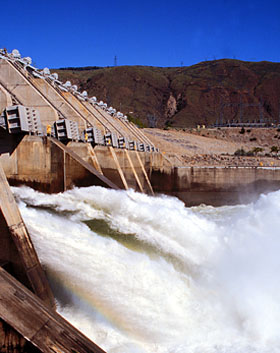
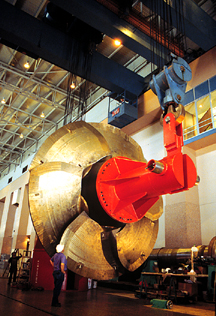
Rocky Reach Dam on the Columbia River and one of it's
turbines being overhauled.
The energy produced from
falling water has been used ever since ancient times. The invention of water
turbines in the nineteenth century greatly changed the ways we could use
that energy. Hydropower produces electricity directly from water pressure
caused by gravity. The water passes through dams, turning giant turbines
which then drive giant generators to produce a constant electric alternating
current. Today, hydroelectric power generation accounts for one-quarter
of the worlds energy sources. In the U.S., hydroelectric power made up the
fourth-largest source of electricity generation, about 7% of the electricity
generation in 2000. Hydropower has significant environmental benefits.
It is a form of low-cost electricity generation that produces no emissions
and little harm to the environment. Some dams however cause more damage
than others primarily by their size. Larger dams have a greater damaging
effect on local ecosystems both up stream and down stream of the dam. A
build-up of silt and sediment at the base of some dams is a common problem.
This sediment can actually build up over time to the actual high of the dam
making it entirely useless. Damming a valley, such as the Hetch Hetchey
Valley in Central California, can completely destroy a natural habitat, including
all biotic characteristics of that valley. Species that were once dependent
on this habitat may sometimes be unable to relocate, therefore they could
potentially disappear. A build-up of gas down stream resulting from rushing
water being ejected from the dam can also potentially make aquatic species
unable to survive in those turbulent waters; this would also limit the ability
for fish to access fish ladders in their seasonal fight up stream to spawn.
When compared to Conventional energy sources, Hydroelectric is certainly
a much less destructive energy source than fossil fuels, and presently the
most reliant and available renewable energy source available.
Solar Energy:

Sunlight, or solar energy,
can be used to generate electricity; heat water; and heat, cool, and light
buildings. Photovoltaic (solar cell) systems use semiconductor materials
such as silicon, similar to those used in computer chips to capture the energy
in sunlight and to convert it directly into electricity via a direct current.
Photovoltaic cells have been used in everything from the solar cells in calculators
to satellites.
Passive Solar Energy:
This method is described as a non-moving parts type of energy capture.
Like a greenhouse, heat from the sun is trapped inside a glass structure,
such as a home or office building.
Active Solar Energy:
This method is described as a moving system of energy. An example can be
described as using pipes on a rooftop that have a cycling water source.
The pipes, being black, absorb the sun's energy heating the water in the
pipes. The water is then cycled through the house for heating or hot water
via an electric pump.
Another technology
for harnessing the sun's energy is a concentrating solar power system, which
uses the sun?s heat to generate electricity. The sunlight is collected and
focused with mirrors to create a high intensity heat source that in turn
can be used to generate electricity through a steam turbine or a heat engine.
Today, some new
skyscrapers in cities around the world including Melbourne Australia and
New York are being fitted with a new photovoltaic technology called thin-film
PV panels. A skin that replaces traditional glass cladding material that
can occupy an entire outside surface of a tall building.
Geothermal:

Geothermal powerplant
at The Geysers near the city of Santa Rosa in northern California.
Geothermal energy is the
use of steam and hot water generated by heat from the Earth to perform work.
These areas of high heat generally occur around the edges of continental
plates or where the earth?s crust overlays magma pools close to the surface,
this energy is expressed in the form of hot springs, geysers, and fumaroles.
Some geothermal power plants use steam or hot water from a natural underground
reservoir to power a generator. Others use hot water to provide direct heat
for residential and other buildings, and for other applications. Hot water
near the surface of the Earth can also be used directly for heat. These
direct-use applications can include heating of homes and buildings, growing
of plants inside greenhouses and even pasteurizing milk. Homeowners and
businesses can tap into geothermal energy through geothermal heat pumps that
are now available on the market to heat and cool their structures. Currently,
geothermal accounts for 17% of renewable electricity generation and 0.3 percent
of total U.S. Electricity supply.
Wind Energy:

Wind energy has
been used since at least 200 B.C. for grinding grain and pumping water.
In the early 20th century, windmills were used on farms in the U.S. to pump
water and sometimes produce electricity. These windmills in the past have
developed today into modern day wind turbines. Wind power uses the naturally
occurring energy of the wind to turn the turbines and generate an alternating
electric current, charge batteries or pump water. These turbines capture
energy by using propeller-like blades that are mounted on a rotor. These
blades are placed on top of high towers, in order to take advantage of the
stronger winds generally higher in elevation. Currently, Wind energy accounts
from 6% of renewable electricity generation and 0.1% of total electricity
supply.
Tidal Energy:
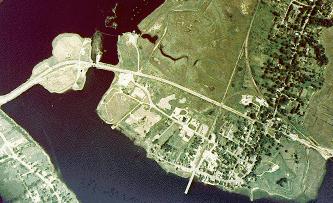
Aerial
photograph of Annapolis Royal, Nova Scotia (pre-tidal power plant)
Ocean
tides and waves contain enormous amounts of energy that can be harnessed
to do useful work. A tidal station works like a Hydropower dam, with its
turbines spinning as the tide flows through them. As the tide moves in,
the water builds up against a dam passing through the turbines toward the
shore. As the tide later moves back out to sea, the pressure pulls on the
water contained within the land side of the dam, causing that water to flow
in the other direction back out to sea while also turning the turbines and
producing electricity. Tidal systems exist today in places of high tidal
activity such as the Bay of Fundy in Nova Scotia.
Biomass Energy:
Biomass is anything
recently living (wood, alcohol, animal and human waste, food waste) that
is going through a process of decomposition. Methane (CH4) is produced by
anaerobic decomposition. This methane can be collected and used to power
small generators for use on farms, small villages and communities on an ongoing
basis sustained by both animal and human waste. Although it does emit CO2,
plants need this to survive, therefore this CO2 can be absorbed by the vegetation
grown to feed livestock and humans.










